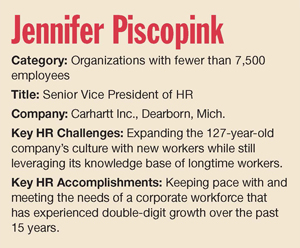This article accompanies Back on Track.
At a company such as Carhartt Inc., makers of durable apparel worn at work sites the world over, “resilient” isn’t just a term to describe its products, but also the workforce it employs, from the stitchers and sewers all the way to the C-suite.
And the term is especially fitting for Jennifer Piscopink, senior vice president of human resources at the Dearborn, Mich.-based clothier. She says the 127-year-old company prides itself on constantly “challenging ourselves to try something, fail at it and move on. That informs our ability to be resilient and focused and learn from our mistakes.”
Piscopink should know. Now with the company for 19 years, she was its first formal HR manager and has built the department, which now includes 140 global HR professionals, from the ground up.
That spirit of resiliency manifested itself when her team experimented with flexible scheduling a few years ago.
“It fell flat on its face,” Piscopink says of the attempt. “We didn’t have senior-leadership support at the time, and the technology just wasn’t there, either.”
After a summer of piloting the flexible-scheduling program through some turbulence, she says, “we got to the CEO’s office and he said it was a fail.”
Undeterred, Piscopink says the episode “made us stronger” by forcing HR to look at the issue from “multiple perspectives.”
Fast forward three years later, and Piscopink’s team reintroduced flexible scheduling, in part by holding roundtable discussions with workers and management to discuss the concept prior to launch. With the appropriate technology and leadership buy-in also in place this time around, Carhartt now offers both flex-work schedules and compressed work weeks to some of its workers.
“We meet the associates where they’re at,” she says. “That’s our goal because there’s no one-size-fits-all approach that will work for everyone.”
Keeping employees happy with their schedules is one piece of the employee-retention puzzle at Carhartt, she says, because of the unglamorous nature of the work.
“We’re an apparel company in Dearborn, Mich.,” she says. “Finding people to work in the corporate office in jobs like designer, head of creative, general merchandise manager, those are tough jobs to fill. And it’s the same thing in our sewing facilities. It’s tough, challenging work.”
Despite those challenges, Carhartt has seen its workforce increase by double-digit percentages over the past 15 years (it currently has roughly 5,200 employees), and Piscopink says keeping the company’s 127-year-old culture relevant to new hires is critical. Indeed, one of Piscopink’s main challenges has been figuring out how to grow the company’s brand and culture with new ideas and experiences from outside the organization, while still honoring and leveraging company traditions and the expert knowledge of Carhartt’s longtime employees.
“We are steeped in history,” she says. “So it’s not a matter of overcoming that culture, but finding the right people to enhance the culture and get us where we want to go. We take our time to hire people. We spend a lot of time on referrals from employees. We look for people who have not just similar experiences, but similar attitudes as well.”
In an effort to better communicate the company’s culture and better support workers’ engagement and total well-being, Piscopink extended the reach of her HR domain to include areas such as internal communications, and health and safety.
“A lot of the HR process is compliance and complaint,” she says. “But we see ourselves as the hub of stewardship. It all blends really nicely with the idea that we need to make sure, from multiple perspectives, that you can use the [HR] space to do your job better. Over the years, we’ve focused on making it a priority. Communication goes naturally with what we do. A lot of what we’re doing is helping get a message out to associates on where we’re going and why.”
Going forward, one area Piscopink hopes to focus on is the family-owned company’s succession-management strategy. “From a company standpoint, it’s something we’re newer to,” she says, but she won’t have to look far for inspiration, as 52 percent of her HR leadership team was promoted into their roles.
 “We want to groom internal talent,” she says. “Over the past few years, there’s been lots . . . going on regarding succession planning. The challenge is going from planning to management. What we’re seeing is a focus on offering associates experiential opportunities, like taking high performers and putting them in roles we wouldn’t have thought about a few years back.”
“We want to groom internal talent,” she says. “Over the past few years, there’s been lots . . . going on regarding succession planning. The challenge is going from planning to management. What we’re seeing is a focus on offering associates experiential opportunities, like taking high performers and putting them in roles we wouldn’t have thought about a few years back.”
To that end, Carhartt CEO Mark Valade says that, as a senior leadership team member, Piscopink “challenges the team to look at other points of view and consistently ensures we consider how every decision will impact our people. The growth and development of our talented team of associates is always top of mind for Jennifer.”
Ultimately, Piscopink says the secret of her success — including a spot on this year’s HR Honor Roll — isn’t really much of a secret at all.
“HR needs to be resilient and I do, too,” she says. “Resiliency aligns well with our brand. That’s what we expect from our team.”

